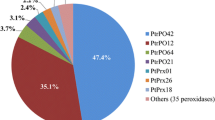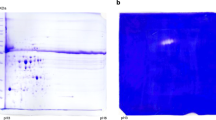Abstract.
Vascular exudates of Cucurbita maxima (Duch.) contain a group of highly conserved serine proteinase inhibitors collectively called Pumpkin Fruit Trypsin Inhibitors (PFTIs) that prevent proteolytic activity of trypsin or chymotrypsin. Polyclonal antibodies raised against PFTIs were used to immunolocalize these low-molecular-weight proteins within the phloem tissue and to study their developmental expression. The inhibitors were translocated throughout the transport phloem and were present in vascular exudates collected from both source and sink tissues throughout the plant. During the early stages of vascular development, PFTIs accumulated specifically in sieve element–companion cell complexes of the phloem tissue. Transcripts were initially detected by reverse transcription-polymerase chain reaction in seedlings 1 d after germination and the protein detected 24 h later. Pumpkin fruit trypsin inhibitors were present in both cell types of differentiating and translocating sieve element–companion cell complexes. The inhibitors were detected in the phloem of the bicollateral vascular bundles, but the protein was most consistently localized within the cortical and bundle-associated extrafascicular phloem.
Similar content being viewed by others
Author information
Authors and Affiliations
Additional information
Received: 3 June 2000 / Accepted: 3 July 2000
Rights and permissions
About this article
Cite this article
Dannenhoffer, J., Suhr, R. & Thompson, G. Phloem-specific expression of the pumpkin fruit trypsin inhibitor. Planta 212, 155–162 (2001). https://doi.org/10.1007/s004250000405
Issue Date:
DOI: https://doi.org/10.1007/s004250000405




